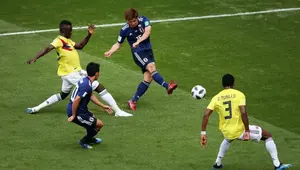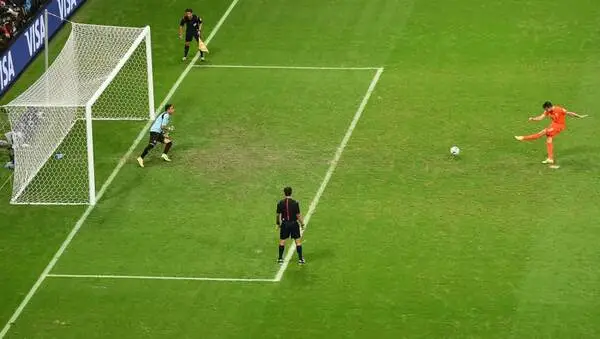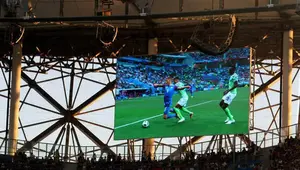Japan squeezed through to the last 16 of the World Cup on Thursday on fair play points, and it left something of a bitter taste in the mouth.
Senegal were knocked out of the tournament simply because they had picked up more yellow cards, which seems like a very subjective way of determining whether a team deserves to advance to the knockout stages.
It also allowed Japan's match against Poland to peter out into farce, with Poland happy to let Japan keep the ball in their own half. The Blue Samurai knew that they were going through unless Senegal scored against Colombia.
A referee's judgement should never be the difference-maker in such a high-stakes tournament, but are there any better methods? Let's size up a few suggestions and see how they'd go down.
1. Goals During Qualification

Stop laughing! This was the metric proposed by BBC analyst, football guru and happy-go-lucky guy Mark Lawrenson during the Japan game. So it deserves to be taken seriously.
Pros
It rewards attacking football in qualification.
Cons
Firstly, it means that some teams come into the World Cup with an advantage over their group opponents, which is a terrible way to start a tournament that is supposed to put everyone on a level playing field.
Secondly, teams from different confederations play wildly differing numbers of games (African teams played 8 games to get to Russia; Australia played 22). This problem could be resolved by using goals per game instead of total goals, admittedly.
Thirdly, the quality of the opposition in qualifying also varies hugely between confederations. The South American group contains 10 teams who would all be worthy of a World Cup place. The European section contains Gibraltar. Enough said.
Finally, Japan scored 44 goals in their 18 qualifying matches at a rate of 2.44 per match, compared to Senegal's 15 in 8 games (1.88 per match), so this would have resolved absolutely nothing.
Verdict
Sorry Lawro. This one ain't gonna fly. 1/10
2. Shots On Target

Whichever team has the most shots on target over their three group games progresses to the knockout stages.
Pros
It encourages attacking football and adventurous play, and it would be quite fun to see a team going hell for leather in the latter stages, taking on shots at every opportunity.
Also, the more shots on target they have, the more likely that one of them will go in, removing the need for a tie-breaker at all.
Cons
This would be equally easy for two teams in the Japan/Poland situation to fix. Lukasz Fabianski keeps rolling the ball out to a Japanese striker, who repeatedly taps it back into his hands. Japan rack up shot after shot and easily go through.
There would also be significant debate about what counts as a shot on target. Is a hoofed clearance, caught by the goalkeeper in front of his goal, a shot on target? Not much of a testament to attacking play, is it?
Verdict
Probably a better method than yellow cards, because it is less subjective (though, as mentioned, still a bit subjective).
Unfortunately, the ease with which it could be fixed means that this won't resolve anything. 3/10
3. Playoff Match

The two tied teams meet up for a playoff match of some sort to decide who goes through. It could be a 90 minute match, or a first-team-wins situation. Free entry for fans.
Pros
The fairest solution, as it involves neither the arbitrariness of yellow cards, the clinical statistics of shots on target, or the lottery of penalties.
This method has been used at the World Cup before, most recently in 1958.
Also, more football.
Cons
Fatigue is going to be a huge problem. Senegal and Japan wouldn't have been able to meet up for a playoff today, having only played yesterday.
If the game was delayed until, say, Saturday, that would still put the victors at a huge fitness disadvantage against their last 16 opponents.
Also, World Cup matches are arranged months in advance, not days. Contigency plans could be made, but the game would have to take place at the location of the potential location of the last 16 match - in this case, Rostov-on-Don.
Verdict
The fatigue factor is the only downside to this idea, but it's a big downside. Maybe two days fewer rest is the punishment for not qualifying by conventional methods? No wait, that's psychotic. 5/10
4. Penalty Shootout Playoff

The ideal situation is that the two tied teams meet in their final game and resolve their differences with a penalty shootout in case of a draw. We very nearly had this at Euro 2008. The Czech Republic and Turkey were two minutes away from a draw and a group stage shootout. Then Nihat Kahveci had to ruin everyone's fun with a dramatic late winner.
But in the case of the Group H situation, Senegal and Japan would have to meet later in the week to settle this like men: with kicks from 12 yards.
Pros
Everyone loves penalties. Penalties are a harsh way to resolve a match between two sides have who have matched each other for 120 minutes, so imagine when they can't be separated after three whole games.
It also makes sense. Penalty shootouts have been used to resolve tied games for decades. It might be a lottery, but it's better than an actual lottery, i.e. the drawing of lots.
Although Japan and Senegal would both have to rush down to Rostov-on-Don from Volgograd and Samara respectively, one can't imagine that fatigue would be a huge issue. Even with the most tired legs, walking from the centre circle to the penalty spot shouldn't be too difficult.
Cons
One or two days fewer to prepare for the last 16 match could be detrimental, but not as much as the physical toll of a full match.
They probably wouldn't open the stadium just for a penalty shootout, which could rob the occasion of some emotion.
There's going to be downsides to every suggestion, but this one seems to be the most watertight.
Verdict
A fair and footballing solution which is already applied in the latter stages of the competition anyway. A tad bizarre, but entirely fair, and even the lengthy travel times shouldn't have too much of an effect. 8/10
5. Simultaneous Penalty Shootouts at Separate Grounds

A penalty shootout for the modern age. If it is possible that a tie-breaking method could be needed, each team would choose a goalkeeper to send to the other match taking place in the group. A shootout would then take place as normal, but with the penalties from the other match shown live on the big screen.
Pros
The same drama as penalties, but with a two-second time delay. What's not to love?
It could also be used to decide three-way ties, as two of the teams could have a conventional penalty shootout while the third team does the weird alternative shootout thing hundreds of miles away. Although which team's goalkeeper would go in goal?
It also means that the third-choice goalkeeper might actually have a reason to exist.
Cons
It's absolutely nuts.
Also, I bet the winning goalkeeper is going to have a great time celebrating with the zero teammates and zero supporters there to congratulate him.
Verdict
Aside from the fact that FIFA would never implement something this barmy in a million years, it's actually not a bad idea.
It doesn't rely on an arbitrarily chosen statistic, it provides the best possible end to a World Cup match, and it can even resolve three way ties...maybe.
However, I don't think anyone wants to see the emotion of a shootout curtailed, and the use of technology coupled with the slightly surreal sight of a goalkeeper celebrating by himself would make this into a very weird outcome.
I think this is now on my bucket list though. 7/10